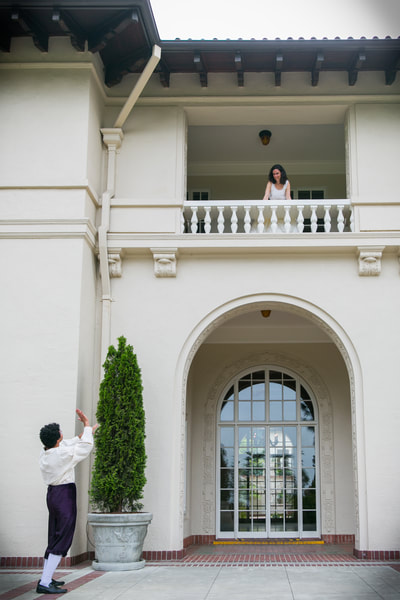For the month of May 2016, the Lucas Artists Residency Program (LAP) turned the eleven artist studios on our orchard site over to the We Players, a remarkable site-specific theater company, as they developed a new production of Romeo and Juliet. Founded 16 years ago by Artistic Director Ava Roy, the We Players adapts classic pieces of theater for historic places and keeps audiences on their toes as their performances wend their way through these striking environments. The We Players have performed Ondine in San Francisco’s Sutro Baths, Macbeth at Fort Point, and Hamlet on Alcatraz, creating once-in-a-lifetime experiences for audience members.
As the We Players cast and crew worked together to develop the underpinnings of their unique approach to Romeo and Juliet, they were joined at the LAP by Monica Lundy, a visual artist and past LAP Guest Artist. Monica Lundy had spent the summer of 2015 in residence at the LAP alongside Ava Roy, and after a month of artist dinners on the picnic tables under the oak trees, they had planted the seeds for a future artistic collaboration. Roy invited Lundy to return to the LAP with the We Players team, to collaborate with them on their new theater production. An artist who creates striking mixed media paintings, Lundy stepped out of her comfort zone and agreed to develop a series of animal-themed masks for a key scene of Romeo and Juliet—the ball at the Capulet residence that initiates the drama of Shakespeare’s classic tragedy of love, risk, and miscommunication.
Over a month, Roy walked with the actors on the trails, orchestrating the exploration and building of their characters. The actors lived and ate meals with each other and did that deep work that actors do—the invisible and little-appreciated preliminary work of coming to understand the characters they will inhabit. They read and reread Shakespeare’s script. In his pajamas on his day off, actor John Steele Jr. made word-cloud images of the animals built of the dialogue of each character. They worked from ten in the morning until ten at night.
And Monica Lundy went to work in the clear light of studio 41. She hand-formed the mask of hummingbird as Romeo walked in Montalvo’s rose garden, learning how that bird loves. She gilded the frizzled brow of the sphinx moth carefully as Juliet explored what it means to love a flame. And the animals came to rest in the characters’ natures, and the characters came and inhabited the animals, and the play was born. The Characters:
| Nurse (quail): Jennie Brick Juliet (sphinx moth, also known as hummingbird moth): Maria Leigh Peter (mouse): Amy Nowak Lady Capulet (mountain lion): Libby Oberlin Benvolio (jackrabbit): John Steele Jr. | Friar Laurence: Rush Rehm Romeo (hummingbird): Mohammad Shehata Tybalt (bobcat) & Paris (heron): Steve Thomas The Prince & Mercutio (coyote): Courtney Walsh |
Image Gallery
Meet the Artists
AVA ROY
Website
Since 2008, Ava Roy has pioneered unique partnerships with both the National Park Service and the California State Park system, creating large-scale performances at park sites throughout the Bay Area. Production highlights include: Hamlet on Alcatraz, Macbeth at Fort Point, The Odyssey on Angel Island, Twelfth Night at Hyde Street Pier, and Ondine at Sutro. Inspired and guided by Shakespeare since her teenage years, Ava has explored many characters from the canon, including Juliet, Olivia, Henry V, Mercutio, Feste, Viola, Lady Macbeth, Cordelia, and Lear’s Fool. Her unique style of interactive, site-integrated performance aims to highlight the historical and natural treasures of the local landscape and encourage new ways of experiencing and appreciating these places.
MONICA LUNDY
Website
Guided by an interest in deepening one’s understanding of place, Monica Lundy threads together historical research and studio practice. Her curiosity about lesser-known histories is paired with her curiosity about unconventional painting practices. While her thematic focus revolves around subjects who exist on the periphery of society—and places whose histories have become obscured over time—Lundy’s technique focuses on the space in which an image breaks down into obscurity or physical degradation. Lundy’s mixed-media paintings bridge painting and installation, abstraction and figuration. Her work ruminates upon the dispossessed, memory, and the corrosive nature of time. Learn more about Monica Lundy at monicalundy.com.
In the News
- Montagues at Montalvo
by Ann Gelhaus, The Mercury News






















